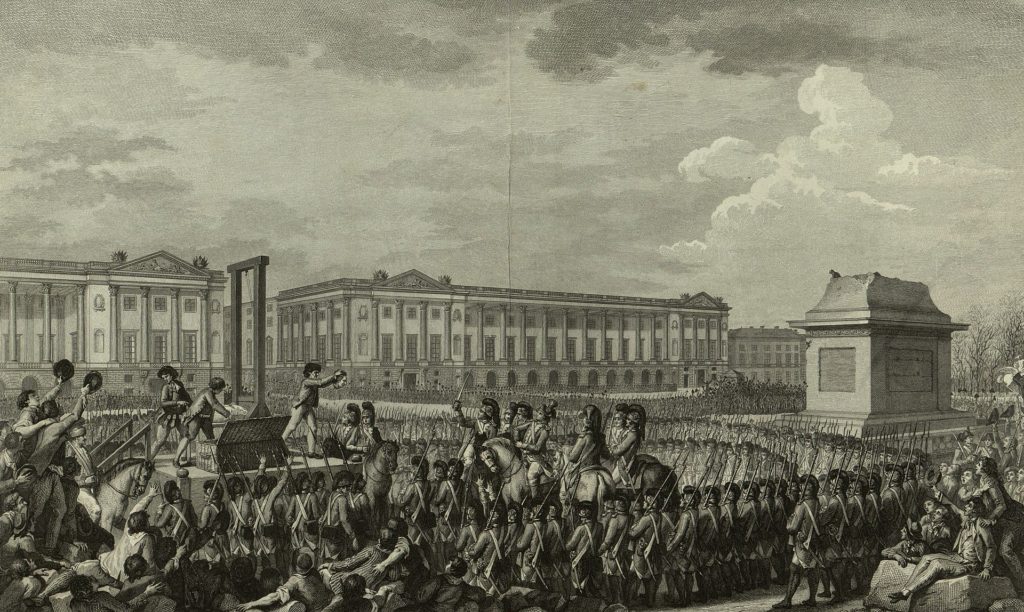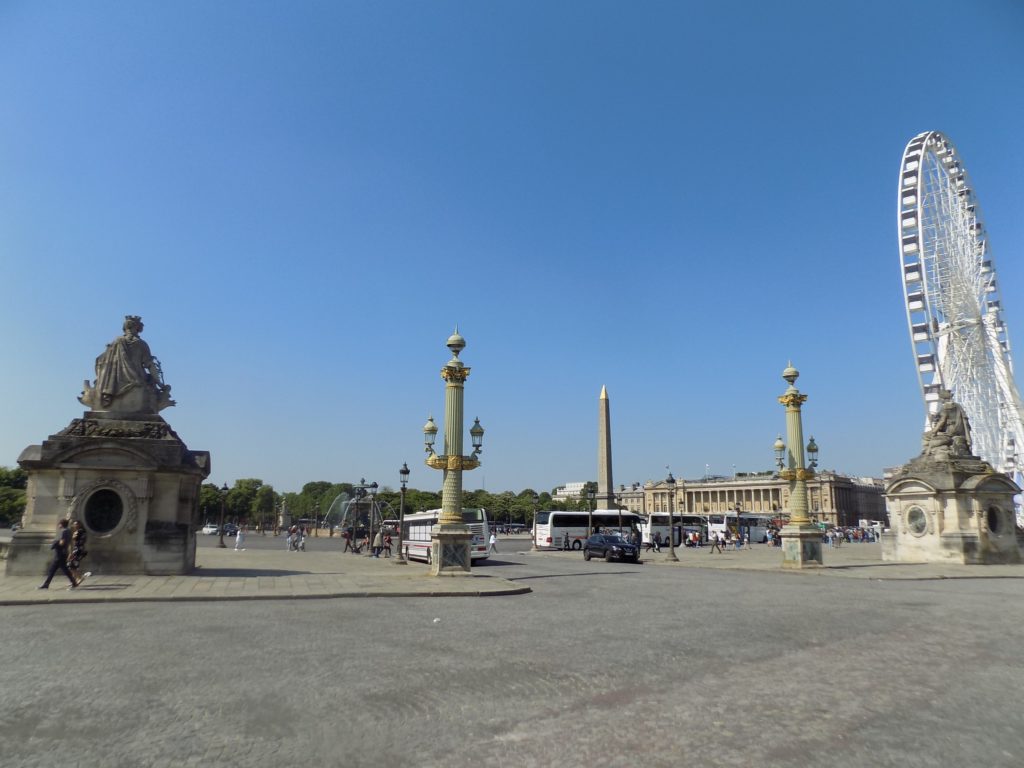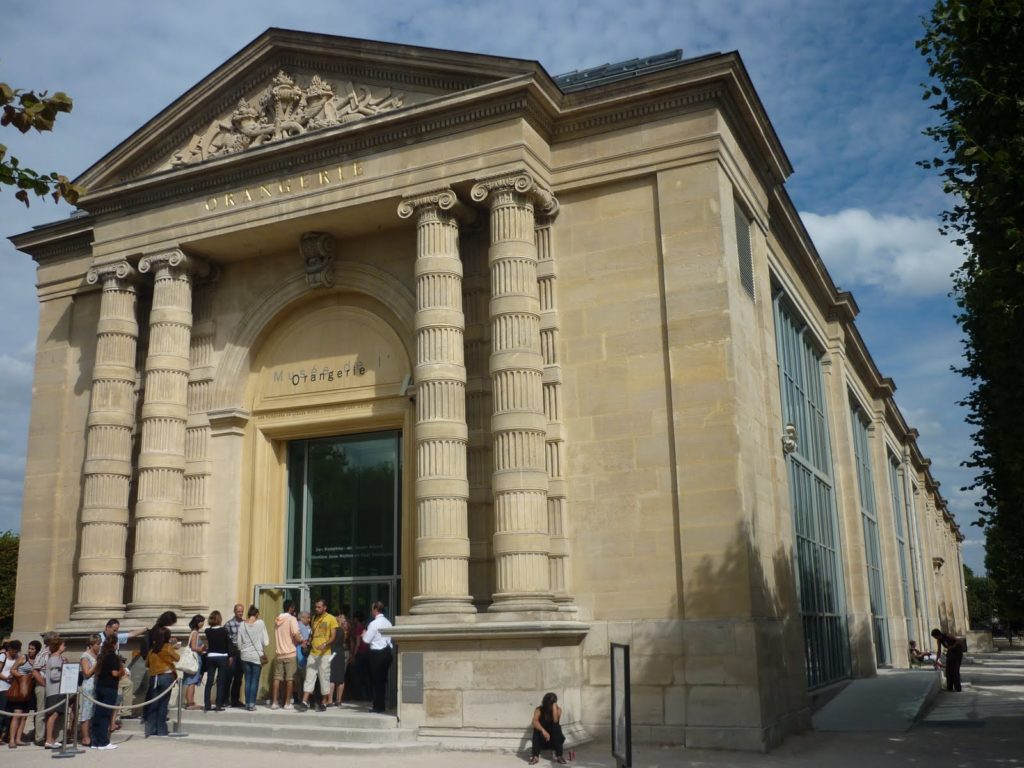Place de la Concorde.
Before moving on to describe our visit to the Orangerie and taking a deeper look at Monet’s Water Lilies, I should write a few words about the Place de la Concorde. Let’s begin with the fact that it hasn’t always been so named and it certainly wasn’t always a place of concord.
Originally shaped as an octagon to formalize some of the space between the eastern terminus of the┬ĀChamps-Elys├®es and the western edge of the Tuilleries, the Place was designed and built in 1755 by Ange-Jacques Gabriel who served as the principal architect for King Louis XV and, in its initial incarnation, it bore the king’s name.
An equestrian statue of the king stood at the center of the Place Louis XV until the last decade of the 18th century when it was torn down by the new revolutionary government. They renamed the square Place de la R├®volution, erected a guillotine, and held many public executions there in front of cheering crowds.
[Executions at Place de la R├®volution – Wikipedia – Public Domain.]
Among the better known whose heads were shaved by the “National Razor” were King Louis XVI, Queen Marie Antoinette, Princess ├ēlisabeth of France, Charlotte Corday, Madame du Barry, Antoine Lavoisier, and ultimately, one of the authors of the Reign of Terror, Maximilien Robespierre. (The guillotine itself has an interesting history and you can read a summary of that history here.)
Six years after the beginning of the Revolution, as a gesture of reconciliation, the five member Directorate decided to rename the square Place de la Concorde. That appellation lasted nearly two decades until the Bourbons came to rule France again after the fall of Napol├®on Bonaparte and restored the square’s original name.
Then, in an act that contained at least a trace of hubris, they renamed the square Place Louis XVI in 1826. That designation lasted only until the 1830 July Revolution when it again took on the name Place de la Concorde and so it has remained.
Looking at the photo below, you can see a pair of elements that graced the Place de la Concorde during our visit.
I use the past tense because, according to an article in The Guardian, the Grande Roue (Big Wheel) was scheduled to be shut down and dismantled in July of this year (2018) so by the time I’ve published this post, the Parisian answer to the London Eye or Washington’s Capital Wheel should be gone from its residence for the past quarter century.
The Luxor Obelisk occupies the center of the square and it is, in fact, one of two obelisks presented by Egypt as a gift to France in the 19th century. The obelisk is 23 meters tall, weighs more than 250 metric tons, and the French had so much trouble transporting it that they deserted the second leaving it in Egypt. Abandonment became a permanent rejection in the 1990’s when then President Mitterrand officially returned it to its original owner. The French government added the gold-leafed cap to the top of this obelisk in 1998. The original cap had been missing for 2,500 years.
Mus├®e de l’Orangerie.
This gate
ornately marks the western edge of Tuilleries. Walk through the gate and you are at the Place de la Concorde. Stay in the garden and walk to the right if you’re inclined to visit the Galerie nationale Jeu de Paume. (Once the home to the Impressionist and Modern Art now found mainly in the Mus├®e d’Orsay and Centre Pompidou, this gallery was originally built for Napol├®on III as a building for the game the French call jeu de paume {a precursor of tennis}. It’s now a center for modern and postmodern photography and media.)
Walk to the left from the photo’s perspective and you can visit the Orangerie.┬ĀBuilt in 1852 under the aegis of Napol├®on III, who had apparently tired of housing trees in the Grande Galerie du Louvre, its original purpose was to serve as a winter home for the orange trees lining the garden of the Tuileries.
(There were, at one time, more than just gardens at the Tuilleries. There was a palace, too. Recall that when King Henri II died at the h├┤tel des Tournelles near the Place de Vosges his widow, Catherine de M├®dici, abandoned and sold the property. Henri died in 1559 and Catherine began building a palace more to her liking in 1564. The tile kilns [tuile fours] that once occupied the area provided the source for its name.
Over the centuries the palace served a number of purposes including housing the Council of 500 in year III after the Revolution [1795] as well as being the imperial residence of Napol├®on Bonaparte in the early 19th-century.
On 23 May 1871, it became just another of the buildings burned by the fleeing Communards. The fires burned for 48 hours and the ruins stood for 11 years before the French National Assembly voted to demolish the remains – a process that began in February 1883 and ended in September. The columns framing the doorways of l’Orangerie are said to echo the portal decorations of the Tuilleries Palace.)
On 12 November 1918, Claude Monet promised his homeland a “monument to peace.” To celebrate the end of World War I, he donated several of his Nymph├®as paintings to France. Then, in 1921, the state gave control of both buildings (Orangerie and Jeu de Paume) to the Under-Secretary of State for Fine Arts with the notion that they would serve to exhibit works by living artists.
Late in his second term as prime minister,┬ĀGeorges Clemenceau suggested using l’Orangerie to house the as yet unfinished large Water Lilies set that Monet had donated. Delighted by the idea, Monet immediately began working with the architect Camille Lef├©vre on the design of the space. Their design used two oval rooms that, when viewed from above form Ōł× – the well-known symbol for infinity.
The finished rooms have an east-west orientation that places them in the path of the sun and parallel to the historical axis of Paris which runs from the Arc de Triomphe to the Louvre. Entering through a vestibule that Monet intended to mark the transition from the outside world, viewers are bathed in natural light filtering through the ceiling that, with his paintings, is intended to immerse visitors in “an illusion of an endless whole, of water without horizon and without shore.” Clemenceau officially opened the museum on 17 May 1927 six months after Monet’s death.
We’ll have a longer look at Les Nymph├®as and I’ll wrap up the day with some music in part three.



